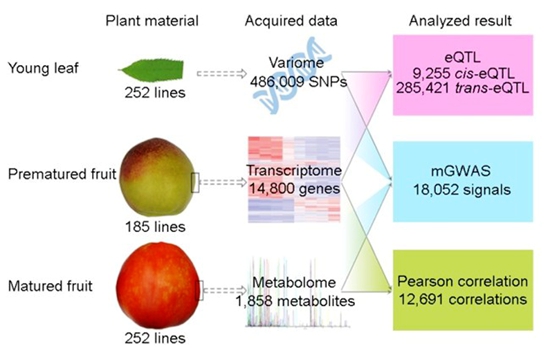Genomic Analyses Reveal the Effects of Natural and Artificial Selection on Peach Fruit Metabolomics
Recently, the Peach Resources and Breeding Innovation Team of Zhengzhou Fruit Research Institute cooperated with Wuhan Maiwei Company to publish a paper entitled "Combined nature and human selections reshaped peach fruit metabolome" in Genome Biology.
Previous studies have shown that under the influence of natural and artificial selection, the types and contents of plant metabolites will change correspondingly, which is beneficial to their own survival and human health. However, it's not clear what the responding metabolites are.

Fig. 1 Flow chart of peach fruit multi-omics analysis
In this study, peach was used as the material, and it was found through multi-omics analysis that flavonoids, an important nutrient in the fruit, showed a downward trend in the evolution process with the decrease of bitter taste. By analyzing the environmental information of original habitats of different landraces, it was found that amino acids played an important role in peach's response to low temperature and drought stress. At the same time, the key genes involved in flavonoid and valine synthesis were discovered, which laid the foundation for functional and resistant fruit breeding.
In addition, it was found that, except citric acid, there were 16 metabolites with obvious differences between the eastern and western breeding groups, showing the characteristics of regional selection, and 8 of them were reported to be related to anticancer activity. In vitro analysis of anticancer activity showed that the fruits of western cultivars had stronger anticancer activity than those of landraces and eastern cultivars (China, Japan and South Korea). Combined with the results of mGWAS, that is, six of the above eight anticancer substances are located in the vicinity of the acid content locus on chromosome 5, we speculated that it may be the selection of peach fruit flavor by breeders and consumers in the east and west that leads to the difference of anticancer activity among different cultivar groups.
This research was supported by the National Key Research and Development Plan (2019YFD1000200) and the Science and Technology Innovation Project of CAAS (CAAS-ASTIP-2016-ZFRI-01). Cao Ke is the first author, and Wang Lirong is the corresponding author.
By Li Yong(liyong02@caas.cn)
-
 Apr 18, 2024Opening Ceremony of the Training Workshop on Wheat Head Scab Resistance Breeding and Pest Control in Africa Held in CAAS
Apr 18, 2024Opening Ceremony of the Training Workshop on Wheat Head Scab Resistance Breeding and Pest Control in Africa Held in CAAS -
 Apr 03, 2024IPPCAAS Co-organized the Training Workshop on Management and Application of Biopesticides in Nepal
Apr 03, 2024IPPCAAS Co-organized the Training Workshop on Management and Application of Biopesticides in Nepal -
 Mar 28, 2024Delegation from the School of Agriculture and Food Science of University College Dublin, Ireland Visit to IAS, CAAS
Mar 28, 2024Delegation from the School of Agriculture and Food Science of University College Dublin, Ireland Visit to IAS, CAAS -
 Mar 25, 2024Director of World Food Prize Foundation visited GSCAAS
Mar 25, 2024Director of World Food Prize Foundation visited GSCAAS -
 Mar 20, 2024Institute of Crop Sciences (ICS) and Syngenta Group Global Seeds Advance Collaborative Research in the Seed Industry
Mar 20, 2024Institute of Crop Sciences (ICS) and Syngenta Group Global Seeds Advance Collaborative Research in the Seed Industry
